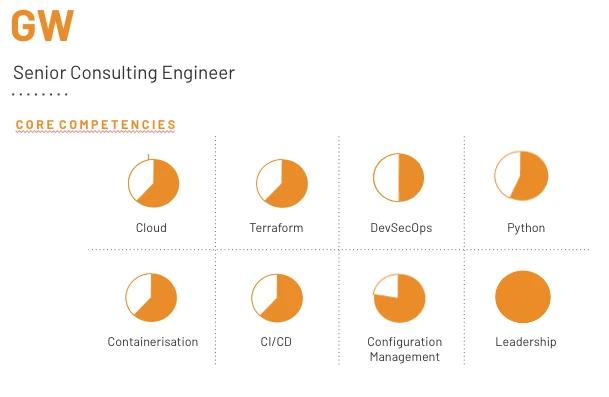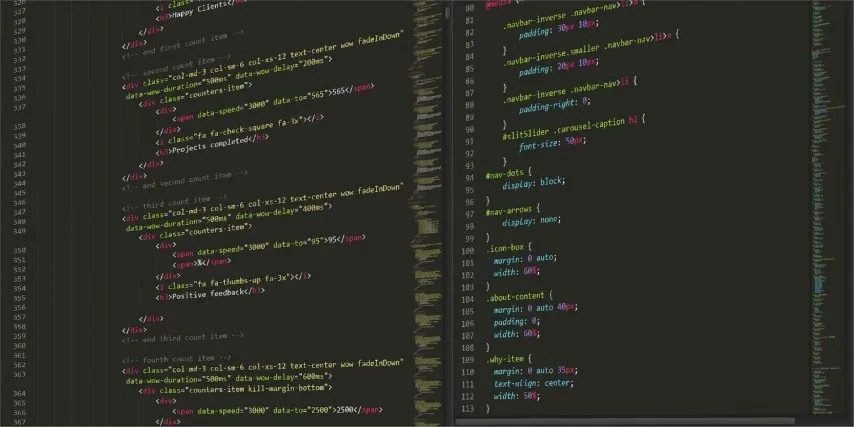I know that there’s a lot of churn going on in the industry right now and a lot of people are suddenly and unexpectedly looking for a new role. Over the past couple of years I’ve had a number of people ask me for advice, guidance, and help writing and updating their CVs. With that in mind I wanted to collate the advice I’ve given and my thoughts on how I go about putting together a good CV in the hope that it might help some of you get back up and into your next role. My partner is a former recruiter with experience hiring developers, DevOps and SRE engineers, and a number of other tech and non-tech roles; I’ve asked her to contribute to this post with some of her thoughts and advice too.
TL;DR
For my American speaking friends… CV in UK parlance is a resume for those of a US leaning. I’ll be using the term CV throughout this post, so keep CV == Resume in mind.
- Keep it short, 1-2 pages, and be sure to keep it to the point
- Highlight your skills right upfront
- Write your CV for the role you want, not the role you have
- Highlight your experience but the reader doesn’t need every detail about what you did in every role
- Focus on things relevant for the role you want
- If it’s not relevant to the role you want, don’t include it
- As an example of how I go about writing a CV check out my Professional Profile
- I have taken the opportunity of it being my website to elaborate on some points but if you keep the above points in mind it will help give you a good picture of what I’m talking about
Remember: Your CV is a marketing document for you, not a story of your working life.
Behind The Scenes
Before we start; just put yourself in the seat of a Talent Acquisition (TA) specialist, recruiter or hiring manager for a moment. Imagine you have 100 applications for a role (at this time in the industry with so many out of work 100 could well be on the low side) and you have 45 minutes until your next meeting (probably more likely 10 minutes!). You don’t have time to read all the way to the bottom of a CV to find out if the person is relevant. You’re probably skim reading too so all those lovely details buried inline with a particular job are going to be missed as well. While I’ll say below that a CV should probably be 1-2 pages long max, during this skim phase if the things the hiring team need aren’t in their faces there’s a good chance they won’t see them at all. It’s not negligence or a lack of attention on their part, it’s human nature and self preservation. From talking to my partner, recruiters typically have mid-teens number of openings (or more) that they’re working on at any given time and with potentially 100s of applications per opening; would you read every word of 1500 CVs? I wouldn’t, honestly I couldn’t!
So! What can we do? The answer is “lots”! So let’s get to it..!
Write Your CV For The Role You Want, Not The Role You Have
This is a really important point and one I’ve seen several times with the folks I’ve worked with. The tendency is to be thinking primarily about the role that you’re currently in or had most recently and write your CV to that. Now, if the role you are looking for next is in the same field this is totally fine, and to be encouraged. However if you’re looking to advance your role, or move into a different field, then you need to be thinking about the role you want and writing your CV to that instead.
What do I mean? Well, if you’re applying for a role as a developer, don’t write your CV highlighting loads of SysAdmin skills. If you’re applying for a role as a DevOps Engineer or SRE, by all means showcase developer skills but don’t forget to demonstrate that you understand operational skills too. If you’re a SysAdmin and are after your next SysAdmin role then this should be easy, highlight the skills you’ve built while working as a SysAdmin. You get the idea…
In practice what this means is that if you’re hoping to land a role as a developer and your previous experience as a Sys Admin includes some scripting type experiences and a bunch of things like “I built servers” or “I managed Office 365” (not being derogatory here, I’m a former Sys Admin) then you absolutely want to focus on those scripting experiences. You’re better off using that precious space on the 1-2 pages your CV should be to showcase that you wrote scripts in bash, PowerShell, python, whatever and that maybe you used git and a git provider like GitHub rather than talking about building a server. Even if it feels like the scripting was ~10% of what you did, it’s the bit that’s relevant to where you want to be so focus on it.
What you’re trying to show here is that you understand what it takes to do the role, that you grasp any associated skills, and that you can offer some evidence of practicing it all. Don’t worry, any recruiter or interviewer will know that not everything you’ve done is on your CV and so if they want to know more about what you did they’ll ask, or you can use those experiences as examples for questions such as “Tell me a time when you had to do X” or “Tell me about a time when you had Y problem and how you solved it”. Obviously adapt the examples to the role you’re applying for.
The, up until now, unwritten part of this is to understand the role that you want and are now applying for. Hopefully, if you’re already in the industry you’ll have some idea, but if not do your research here. Knowing git probably won’t help much if you’re looking to move into something like Technical Account Management, but knowing how to communicate with other teams and ideally customers will do. So, pick the skills you highlight based on the skills that you have that most closely match the role you’re applying for. If you’re struggling for matches, and you’re sure that it’s the right move for you then you can do 2 things. One, highlight all the transferable skills you have; two, see if you can find ways to develop the skills that might be helpful while you’re searching.
Highlight Your Skills Right Upfront
This is another critical one, and another that I’ve seen people get wrong. Typically people list the skills they have, or technologies they have used, against the particular job in the work history that it relates to. E.g.
- Work History
- 2018 - Present: Developer At Company X
- Key Technologies: Python, Go, Git
- Responsibilities: Writing code, fixing bugs, writing tests, writing documentation
- 2014 - 2018: Sys Admin At Company Y
- Key Technologies: Bash, PowerShell, Git
- Responsibilities: Writing scripts, managing servers, managing Office 365
This is a great way of saying what you did at a particular job, but it’s not a great way to showcase all of your skills in a way that’s quick and easy to read and digest for the hiring team. Instead; think of your CV less of a story of your working life and more of a list of the skills you have accumulated. You can add some evidence later on to back that up, and add further colour to it at interview if needed.
I’ve also seen people start off in the right way by collating a list of skills and qualifications, similar to a list of education or hobbies, but then putting it at the end of the CV alongside their education from 5, 10, 20 years ago. Great job collecting them all together; but why are you hiding your skills at the end? While I’m here, unless your education relates to the role you’re going for send it down the running order of details, absolutely include it, but ask yourself is it relevant to what you’re doing now? Remember “skills upfront”!
What you really want to do early on is put in front of the screening recruiter or hiring manager a list of skills that you have that are relevant to the role you’re applying for. This way it’s one of the first thing they see.
So, you have your skills, and you have them at the top of the CV, what else can you do? Well, for one don’t waste a huge amount of space in a long bullet pointed list taking up just the left side of the page. Be creative, and also consider what you might want to see if you’re the one hiring. Personally I go for a 2 column list on my CV and a table on my online Professional Profile. At work we use Engineer Profiles as part of the package sent to customers when starting an engagement and introducing the assigned engineers, and on these we pick a maximum of 8 skills and present them as pie charts of experience. See below for an example that gives a quick visual representation of the skills an employer might most be interested in.

Or, below is an example taken from the Skills Summary on my Professional Profile you can see that in 10 lines I’ve packed in 40+ skills the people might be interested in.
| DevOps & Development Tools | Certifications & Other Skills | Platforms and Operatings Systems |
|---|---|---|
| Kubernetes | MCSA Windows 2016 | AWS |
| Python, bash, PowerShell | MCSA Windows 2008 | Azure |
| AWS CDK | MCSE Window Server 2003 | Hyper-V |
| Ansible | UACA - Ubiquiti AirMax Certified Administrator | VMware |
| Jira, Bitbucket, GitHub, Azure DevOps | Switching & Routing | Nutanix |
| MS-SQL, PostgreSQL | Wireless Network Design & Implementation | Windows Server 2003-2019 |
| Prometheus, Grafana, InfluxDB | VoIP | Red Hat Enterprise Linux (RHEL) |
| AWS EC2, ELB, EKS, Route53, CodeBuild | Active Directory | Ubuntu |
| Jenkins | Microsoft Exchange | Amazon Linux |
So, get creative and try out how you can pack in as many of your relevant skills as possible into the smallest area while still being readable. If it’s too cramped, go back to reassess which skills are relevant and cut back accordingly. If it’s too sparse and you feel like you wish you had more skills to detail then experiment with something more eye catching like the pie charts. At least this way you might catch their attention with something different visually and if it works they’re reading your CV, and your skills and not someone else’s.
Jobs Listed Most Recent First
Previously I didn’t think this one needed to be said, but I saw some recruiters I’ve worked with previously posting about this on LinkedIn; so let’s cover it here too.
This one kind of goes in line with keeping it relevant in that your most recent roles are more likely to be connected and relevant than your historical roles. So, list your work history starting with the most recent first and then work backwards from there. Employers are more likely to care about what you’ve been doing in the last week, month, year, than something from 5, 10, 20 years ago. Again, your CV is a sales advert for you, not a chronological history of your working life.
Keep It Relevant, Keep It Short
We’ve already talked about the relevance thing, but as you read and re-read your CV keep testing yourself, “is this relevant”? I know you probably enjoyed administering Microsoft 365 and are really proud of that project to install Windows 7 to 30,000 machines in 2009 but would a hiring manager for a role as a developer care? Probably not; not trying to be blunt but it probably won’t help you write good Rust code today right? So don’t waste that precious space; use that space to talk about the things that are relevant or to make those relevant things stand out visually.
…and yes, I did say read and re-read your CV. Read it to find spelling mistakes, read it to make sure it’s relevant, read it to make sure it’s not too long, read it to make sure it’s not too short, and definitely get someone else to read it to see if it’s all of those things as well as engaging and interesting. Maybe throw it down on the coffee table with the magazines (or tablets, I realise it’s 2023 after all) and see if your family or friends spot it and pick it up. Remember, you’re trying to sell yourself above everybody else out there hoping to land a job, so like that advert you just saw that prompted you to buy that thing (you probably don’t really need)… catch eyes, stand out and be memorable.
As for keeping it short, hopefully you’re starting to see the pattern here? It’s quality over quantity, you want to get the maximum amount of useful information over in the fewest number of seconds. With that in mind you typically don’t need full sentences for most of your CV, bullet points are much more effective. Unless you’re writing a short introductory bio, in which case use sentences here please. If your skills upfront gets you into the pile for interview then the recruiter probably still hasn’t read page 5 of your extensive work history and the hiring manager probably had 10 minutes to read your CV before they had to go to the next meeting. So, they’ve not read it either or at most they’ve seen a handful of keywords that jumped off the page at them. I’ve only had one interview where someone went into great detail on my background and they actually picked up on my website from the very top of my CV and came to this site to read things, they probably still didn’t get to the bottom of the CV itself! So, keep it short, keep it relevant, keep it engaging and keep it memorable.
Have A Bio At The Top
These days I really don’t see much call for covering letters; certainly I’ve not used one in a very long time. With that in mind having a short biography paragraph introducing yourself and some highlights can be a good opening. Also, here is your space to showcase that you can write coherently and in full sentences. Much like this section, it shouldn’t be super long, at the end of the day you need space to showcase those skills, right? Equally, do give them the highlights, why you, what can you bring, what are you looking for, what do you enjoy or what do you want to achieve? These are all good things to include in your bio.
Focused On Business Outcomes; Use Numbers
Depending on your role this one can seem more, or less tricky, so let me try and break it down for you. The whole goal of this one is to show 2 things. One that you are aware of the business context(s) in which you work, and two, how you individually can bring value to the team and company towards the business goals.
If you’re early in your career, and perhaps in a Support role, maybe this is about having a 95% success rate of meeting first response SLA on new tickets where the team average was 92%. Or maybe you’re more senior and delivered new training materials to the team, or changed a strategy which resulted in a 10% increase in developer velocity. It’s not always possible in some roles to do this, but be on the look out for opportunities to do so.
If this seems far off and like “I just do my job, I don’t really know what the team stats are” or whatever, I get it, but that’s the whole point. For a long time all I did was just crunch tickets in Support. I did a good job, got a lot done, but I had no concept of the value I was bringing until my organisation started posting stats on ticket close rates. It was then that I realised that it was always myself and one other engineer at the top of the charts. Back then it wasn’t about percentages, just overall close numbers in a month, but it was the start for me. I became competitive, wanting to top the charts every time I looked, and I know that my colleague was doing the same. Then other engineers wanted in on the action at the top of the board and so it became about retaining my lead. Anyway, other than numbers sometimes being a motivator I started to be interested in just what percentage of the overall team’s work the top 2-3 of us were doing and what was my number in that. So, now I can talk about at the point in my career I was individually covering 9-11% of the overall team throughput in a team of 50(ish) engineers. It’s not the best statistic to talk about in that it probably shows issues in the team that needed addressing, but already I started to have business context.
Actually, extending on from that example I was then able to talk about taking a leading role to improve overall team performance and delivering training sessions that produced an average 18% improvement on throughput for the engineers previously in the bottom 10% over the following 6 months. Disclaimer these numbers are approximate, I made the mistake of not actually capturing those numbers at that point in my career! Hopefully though you can get the idea? Start by looking at what you’re doing and see how that fits in the overall team picture. From there you have a starting point to talk about how you can improve the team’s performance and how you can help the team achieve the business goals. This works well for both your current role as well as for your CV by the way!
It’s not always easy to hit this one and you don’t need it for every point and role, but it’s a good one to try and be aware of and aim for.
Don’t Be Afraid To Be Creative, Or Different
I’ve already mentioned pie charts, but there are other ways to be creative. I’ve seen people use icons to represent the technologies they’ve used, I’ve seen people use colour to highlight the technologies they’ve used. Obviously do not use 96 colours and 8 different fonts but think about ways to make the information that you want them to see pop out and visually hit them in the face and say “look at me”. Be selective though, remember not all recruiters are familiar with all the technologies they might be hiring for. Putting the Go-pher logo on your CV might be a great way to show you’re a Go developer, but if the recruiter doesn’t know who the Go-pher is and that it relates to Go they’re not going to know what you’re talking about or realise that you’re the one for them. So the icons I mentioned earlier might be a bold play and not the best choice! My advice here is find interesting styles to make your CV pop, but don’t come over like a creative arts major; unless of course that’s the role you’re applying for, in which case, make hay my friend.
For me, I tend to stick to relatively subdued and “professional”. I use columns, tables, and page formatting a lot to squeeze information into the smallest space while still being readable. It really is use of the dead white space on the right hand side of a left justified page that I’m trying to fill. It means I need to focus on giving enough spacing between sections so that it’s not a huge wall of text, but it does make the document look very different from most of the rest on the desk. As an example I’ll put a link to my online presence after my table of skills, it acts as a break line while also conveying useful information, and, of course, on screen at least it adds a blue link into a black text on white background page, a useful colour break. So, based on my personal approach, tread carefully here so as to not overdo it, but getting creative means you can fit more into the same space and make your CV stand out.
Link Out To Your Online Presence
If you feel that you have a bigger story to tell, or other resources can help sell you as a candidate then link out to them. I’ve already mentioned that I put my website link into my CV, but you could also link out to your GitHub, your LinkedIn, your Stack Overflow, your blog, whatever sells you best. But remember it’s an add-on to your CV, not the replacement. Your CV still needs to get through the recruiter screening process before any hiring manager or interviewer will get your CV to consider learning more about you. Also, be cautious here, I don’t recommend social media like Twitter or Facebook because unless you run professional accounts on those platforms, they’re not really a good place to put your professional face forward. Lastly here, be aware that employers do often search for candidates online so make sure there are no skeletons in the closet that might come back to bite you. I’m not saying you need to scrub your social media history, but be aware that it’s there and that it can be found.
Anyway! What you can do is make those online presences work to draw people to you though! LinkedIn is the obvious example; so many recruiters work on LinkedIn that it’s often where they see you first and they ask for the CV only after you’ve started a discussion. Personally, I consider LinkedIn my digital CV and as close as possible they match each other. I also take the opportunities from LinkedIn to add detail and depth to my profile such as leveraging the skills matrix and adding skills to roles etc. Mostly this just helps the keyword bingo aspect of recruiter searches but it all helps. So think of LinkedIn as part of your CV and spend the time here too while you’re working on your CV.
If you’re active on GitHub, or Stack, or some other site that relates to your work and can help paint a richer picture of you as the perfect candidate link to it from everywhere so the folks can find one of your presence points and can learn more by exploring the others. There’s a reason for all these links in my author profile on the side 😉. My other online profiles like LinkedIn and Twitter all have links back to this site etc. I’m not saying you need to go to this level of detail, but hopefully you get the idea.
Lastly, if you have have certifications and qualifications, or do online courses like Pluralsight or Udemy etc., if they offer public access listings of your qualifications use them. It’s not that people won’t believe you if you say you have Microsoft cert X or Hashicorp cert Y, but if you can prove it by showing them where to validate what you say for themselves then it builds your standing as a credible candidate.
Revise And Update
Some advocate for updating your CV for every role you apply for; personally I say don’t bother with that. If you’re focused on a particular role type and you’ve followed the steps above then a well written CV that’s focused on that role will work well for many employers and opportunities.
That said, if you’re applying for different types of roles then you should have different CVs for each.
Next, update it regularly and ideally keep a record over time. Few of us stand still in life for long, we’re often learning something or working on that next thing that directly or indirectly teaches us something new, so make sure your CV tracks that. Right now, as I write this article I know I’ve been upskilling on Terraform and CI/CD pipelines and have delivered some projects leveraging both, so I need to go and update my skills summaries (on my CV, this site and LinkedIn, probably my work profile too!) to reflect that.
I say keep a record over time because it’s often nice to just have a look back and see how you’ve developed. Especially now, if you’re looking for that next role and life feels like it sucks and you’re not getting anywhere, it’s nice to look back and see how far you’ve come and how much you’ve achieved. It can sometimes be the motivation you need to keep going.
Keywords
There’s a reason I’m coming to this late on! A lot of people seem to think that the best approach is to stuff a bunch of keywords and buzzwords into a CV, or resume, to get the attention of recruiters and any AI assistance that they may have. To (a small) point it’s not wrong, and certainly detailing things they are looking for is key. The thing is, it’s really obvious to many folks reading your CV and even more so at interview if you’ve just keyword stuffed and don’t really know your stuff. As an interviewer you very quickly realise when someone has maybe the marketing one-liners about technology A or strategy B but has no depth of knowledge.
So, follow my tips above about raising your skills to the top and keeping the points short and relevant and your natural skills and experience will float to the top by doing so without resorting to keyword stuffing.
It is sometimes a fine line; I would not advocate for putting, say, Terraform in your skills list if you looked at someone else’s code once and copy pasted it into your own project. But similarly don’t make the mistake of not listing it if you think you only know a little. My rule of thumb is that if you can explain something you did with a technology and maybe have an opinion on how it went or what you’d do differently next time then you know enough to list it. If you can’t explain anything about it without Google by your side then it’s not a skill that you have.
Summing Up
So, that’s my advice for now, I really hope it helps you. There’s so many schools of thought on CVs and resumes and everyone claims to have that secret sauce. These are the things that have worked for me time and again. Of course there’s more than just the CV to a successful job search, and maybe I’ll pick up on some of those other aspects in future articles. But for now, I hope this helps you get your CV in shape and helps you land that next role.
Remember, your CV is your chance to sell yourself in the best light you can and in the way you want to be seen. So give it the love and attention it, and you, deserve.
Good luck!
If this article helped you in any way please consider sharing this article with your friends and colleagues, or let me know via LinkedIn or X / Twitter. Also don’t forget to check out my other articles and knowledge posts, hopefully you’ll find something else that helps you there too. Right now, it’s a tough time for us all, none of this is easy, and we should look out for those struggling; so if I can help you find the next one or get started please do get in touch. If you have any ideas for further content you might like to see, or would help you, please let me know too.




